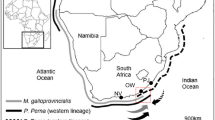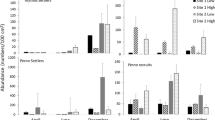Abstract
Musculista senhousia is a small, infaunal mussel native to Asia. Over the last 75 yrs, humans have unintentionally introduced it to various parts of the world, including the Mediterranean, Australasia, and North America. Recently,M. senhousia has become abundant in Mission Bay, San Diego, California. Here, the mussel exhibits many traits typical of opportunistic species. It is small, only attaining a maximum length of about 32 mm, and is capable of rapid growth, reaching up to 25 mm after 1 yr. In San Diego, there was a major peak of recruitment during the late fall of 1990, and low levels of background recruitment throughout much of the year. Although the maximum life span ofM. senhousia is approximately 2 yr, mortality is high and most of the population are only annuals. OverallM. senhousia appears to display similar life-history characteristics both in this invaded system and within its native range.
Similar content being viewed by others
Literature Cited
Anonymous. 1965. Report of survey on protected shellfish fishing ground. Chiba Prefecture Inshore Fishery Experiment Station, Chiba, Japan. (in Japanese)
Barash, A., andZ. Danin. 1971. Mollusca from the stomach ofSparus auratus fished in the lagoon of Bardawil.Argamon 2: 97–104.
Barash, A., andZ. Danin. 1972. The Indo-Pacific species of Mollusca in the Mediterranean and notes on a collection from the Suez Canal.Israel Journal of Zoology 21:301–374.
Benson, W. H. 1842. Mollusca, p. 486–490.In T. Cantor (ed.), General Features of Chusan with Remarks on the Flora and Fauna of that Island.Annals and Magazine Natural History 9: 481–493.
Bertness, M. D., andE. Grosholz. 1985. Population dynamics of the ribbed mussel,Geukensia demissa: The costs and benefits of an aggregated distribution.Oecologia 67:192–204.
Beverton, R. J. H., andS. J. Holt. 1957. On the dynamics of exploited fish populations.Fishery Investigations. Series 2, 19: 1–533.
Butman, C. A. 1987. Larval settlement of soft-sediment invertebrates: The spatial scales of pattern explained by active habitat selection and the emerging role of hydrodynamical processes.Oceanography and Marine Biology Annual Review 25:113–165.
California Regional Water Quality Control Board. 1977. A water quality study of Mission Bay. San Diego County Department of Public Health, San Diego, California.
Carlton, J. T. 1979. History, biogeography, and ecology of the introduced marine and estuarine invertebrates of the Pacific Coast of North America. Ph.D. Dissertation, University of California, Davis, California.
Carlton, J. T., andJ. B. Geller. 1993. Ecological roulette: The global transport of non-indigenous species.Science 261:78–82.
Chiba, K. 1977. On the ecology of the bivalveMusculs senhosia.Marine Science Monthly 9:13–17. (in Japanese with English summary)
Chuang, S. H. 1961. On Malayan Shores. Muwu Shosa, Singapore.
Crooks, J. A. 1992. The ecology of the introduced bivalve,Musculista senhousia, in Mission Bay, San Diego, M.S. Thesis, San Diego State University, San Diego, California.
Dare, P. J. 1976. Settlement, growth, and production of the mussel,Mytilus edulis L., in Morecambe Bay, England,Fishery Investigations. Series II, 28:1–25.
Dayton, P. K. 1984. Processes structuring marine communities: Are they general?, p. 181–197.In D. P. Strong, Jr., D. Simberloff, L. G. Abele, and A. B. Thistle (eds.), Ecological Communities: Conceptual Issues and the Evidence. Princeton University Press, New Jersey.
Dexter, D. M. 1983. Soft bottom infaunal communities in Mission Bay.California Fish and Game 69:5–17.
Ebert, T. A. 1987. Estimating growth and mortality parameters by nonlinear regression using average size in catches, p. 35–44.In D. Pauly and G. R. Morgan (eds.), Length-Based Methods in Fisheries Research. Sufat, Kuwait.
Eckman, J. E. 1983. Hydrodynamic processes affecting benthic recruitment.Limnology and Oceanography 28:241–257.
George, E. L., andN. B. Nair. 1974. The growth rates of the estaurine molluscMusculista arcuatula Yamamoto and Habe (Bivalvia: Mytilidae).Hydrobiologia 45:239–248.
Guan, F., Y. Han, andW. Qu. 1989. On the habitat on growth ofMusculus senhousei (Benson).Journal of Fisheries of China 13: 181–188. (in Chinese with English summary).
Hall, S. J., D. Raffaelli., andS. F. Thrush. 1994. Patchiness and disturbance in shallow water benthic assemblages, p. 333–375.In P. S. Giller, A. L. Hildrew, and D. G. Raffaelli (eds.), Aquatic Ecology. Scale, Pattern, and Process. Blackwell Scientific Publications Oxford, England.
Heller, J. 1990. Longevity in molluscs.Malacologia 31:259–295.
Hoenselaar, H. J., andJ. Hoenselaar. 1989.Musculista senhousia (Benson in Cantor, 1842) in the Western Mediterranean (Bivalvia., Mytilidae).Basteria 53:73–76.
Hopkins, D. R. 1986. Atlas of the distributions and abundances of common benthic species in San Francisco Bay, California. Water Resources Investigations Report 86-4003. United States, Geological Survey, Denver, Colorado.
Hurlbert, S. H. 1990. Spatial distribution of the montane unicorn.Oikos 58:257–271.
Hutchings, P., J. van der Velde, andS. Keable. 1986. Guidelines for the conduct of surveys for detecting introductions of non-indigenous marine species by ballast water and other vectors and a review of marine introductions into Australia. The Australian Museum, Sydney, Australia.
Kato, S. and H. Akiyama. 1959. Seasonal appearance of pelagic larvae ofMusculista senhousia in Naka-umi, a brackish lagoon. Reports of the Shimane Prefecture Fisheries Experimental Station, Shimane, Japan. (in Japanese)
Kawaguchi, M. andK., Shirai. 1944. Studies on bays of Setonakai, I. Benthic community of Kasaoka Bay and a quantitative evaluation ofBrachidontes senhousia as an unutilized natural resource.Contributions in Physiology and Ecology, Kyoto Imperial University 8:1–18. (in Japanese)
Kawahara, T., T. Iwaki, K. Hibino, andY. Sugimura. 1979. Fouling communities in Yokkaichi Harbor.Publications of the Amakusa Marine Biological Laboratory 5:19–30.
Kawahara, T. andD. Katou. 1970. Artificial inducement of spawning and larval development in a mussel,Musculus (Musculista) senhousia.Aquiculture 17:247–261. (in Japanese)
Kikuchi, T. 1964. Ecology and biological production of Lake Nakaumi and adjacent waters, 3. Macrobenthic communities of Lake Shinji-ko and Lake Naka-umi.Special Publications of the Seto Marine Biological Laboratory, Series II. Part 1:21–44.
Kikuchi, T. andJ. M. Péres. 1977. Consumer ecology of seagrass beds, p. 147–193.In C. P. McRoy and C. Helfferich (eds.), Seagrass Ecosystems. A Scientific Perspective. Marcel Dekker, Inc., New York.
Kincaid, T. 1947. The acclimatization of marine animals in Pacific northwest waters.Minutes Conchological Club of Southern California 72:1–3.
Kulikova, V. A. 1978. Morphology, seasonal population dynamics, and settlement of larvae of the bivalve molluscMusculista senhousia in Busse Lagoon (South Sakhalin)Soviet Journal of Marine Biology 4:769–773.
Kulikova, V. A.. 1979. Reproduction peculiarities of bivalve mollusks in Busse Lagoon in relation to water temperature.Soviet Journal of Marine Biology 5:25–48.
Levin, L. A. 1982. The roles of life history, dispersal, and interference competition in the population and community structure of a dense infaunal polychaete assemblage. Ph. D. Dissertation, University of California, San Diego, California.
Levinton, J. 1972. Stability and trophic structure in depositfeeding and suspension-feeding communities.The American Naturalis 106:472–486.
Lin, J. 1991. Predator-prey interactions between blue crabs and ribbed mussels living in clumps.Estuarine, Coastal and Shelf Science 32:61–69.
Lodge, D. M. 1993. Biological invasions: Lessons for ecology.Trends in Ecology and Evolution 8:133–136.
MacDonald, K. B. 1969. Quantitative studies of salt marsh mollusc faunas from the North American Pacific Coast.Ecological Monographs 39:33–59.
MacDonald, K. B., R. F. Ford, E. B. Copper, P. Unitt, andJ. P. Haltnier. 1990. South San Diego Bay enhancement plan. Resource Atlas. Volume one. Michael Brandman Associates, Inc., San Diego, California.
Marcus, L. 1989. The coastal wetlands of San Diego County. State Coastal Conservancy, California.
Morisita, M. 1964. Application of Iδ-index to sampling techniques.Researches on Population Ecology 6:43–53.
Morton, B. 1974. Some aspects of the biology, population dynamics, and functional morphology ofMusculista senhausia Benson (Bivalvia, Mytilidae).Pacific Science 28:19–33.
Morton, B. 1989. Life-history characteristics and sexual strategy ofMytilopsis sallei (Bivalvia: Dreissenacea), introduced into Hong Kong,Jornal of the Zoological Society of London 219:469–485.
Mukai, H. 1974. Ecological studies on distribution and production of some benthic animals in the coastal waters of central inland Sea of Japan.Journal of Science of the Hiroshima University, Series B, Division 1, 25:1–82.
Palmer, A. R. 1981. Do carbonate skeletons limit the rate of body growth?.Nature 292:150–152.
Pianka, E. R. 1970. On r- and k-selection.The American Naturalist 104:592–597.
Ricker, W. E. 1975. Computation and interpretation of biological statistics of fish populations.Bulletin of the Fisheries Research Board of Canada 191:1–382.
Sastry, A. N. 1979. Pelecypoda (excluding Ostreidae), p. 113–292.In A. C. Giese and J. S. Pearse (eds.), Reproduction of Marine Invertebrates, Volume 5. Molloscs: Pelecyopods and Lesser Classes. Academic Press, New York.
Seed, R. 1976. Ecology, p. 13–65.In B. L. Bayne (ed.), Marine Mussels: Their Ecology and Physiology. Cambridge University Press, London.
Slack-Smith, S. A. andA. Brearley. 1987.Musculista senhousia (Benson, 1842); a mussel recently introduced into the Swan River estuary, Western Australia (Mollusca: Mytilidae).Records of the Western Australian Museum 13:225–230.
Strathmann, M. F. 1987. Reproduction and development of marine invertebrates of the northern Pacific coast. University of Washington Press, Seattle, Washington.
Sun, D. andZ. Tang. 1989. Ecological characteristics of macrobenthos of the Huanghe river estuary and adjacent waters.Studia marina Sinia 30:260–274. (in Chinese with English summary)
Takahashi, E. 1992. A comparison of the macrobenthos of transplanted and natural eelgras (Zostera marina L.) beds in San Diego Bay. M. S. Thesis. San Diego State University, San Diego, California.
Tanaka, M. andT. Kikuchi. 1978. Ecological studies on benthic macrofauna in Tomoe Cove, Amakusa. II. Production ofMusculista senhousia (Bivalvia, Mytilidae).Publications of the Amakusa Marine Biological Laboratory 4:215–233.
Thayer, C. W. 1975. Morphological adaptations of benthic invertebrates to soft substrata.Journal of Marine Research 33:177–189.
Thompson, J. K. andF. H. Nichols. 1988. Food availability controls seasonal cycle of growth inMacoma balthica (L.) in san Francisco Bay, California.Journal of Experimental Marine Biology and Ecology 116:43–61.
Uchida, A. 1965. Growth of a musselMusculista senhousia and the influence ofMusculista senhousia on the clamTapes philippinarum. Reports of the Chiba Prefecture Inshore Fisheries Experimental Station. 7:69–78. (in Japanese)
Willan, R. C. 1985. Successful establishment of the Asian musselMusculista senhousia (Benson in Cantor, 1842) in New Zealand.Records of the Auckland Institue and Museum 22:85–96.
Willan, R. C. 1987. The musselMusculista senhousia in Australasia; another aggressive alien highlights the need for quarantine at ports.Bulletin of Marine Science 41:475–489.
Woodin, S. A. 1976. Adult-larval interactions in dense infaunal assemblages: Patterns of abundance.Journal of Marine Research 34:25–41.
Yoshida, Y. 1937. On the pelagic larvae and young ofBrachidontes senhousi (Reeve).Venus 7:121–128. (in Japanese with English summary)
Author information
Authors and Affiliations
Rights and permissions
About this article
Cite this article
Crooks, J.A. The population ecology of an exotic mussel,Musculista senhousia, in a Southern California Bay. Estuaries 19, 42–50 (1996). https://doi.org/10.2307/1352650
Received:
Accepted:
Issue Date:
DOI: https://doi.org/10.2307/1352650




